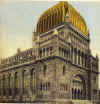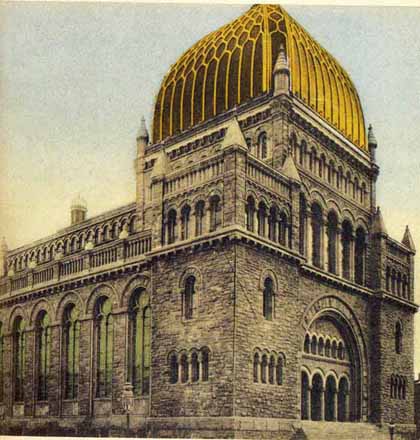 |
New York
Architecture Images- Gone Temple Beth-El |
|
architect |
Arnold Brunner |
|
location |
Fifth Ave. and 76th Street |
|
date |
1891 |
|
style |
Romanesque Revival with Moorish Revival influences |
|
construction |
Indiana limestone |
|
type |
Synagogue |
|
images |
 |
|
Jewish Heritage Report Vol. I, No. 2 / Summer 1997 Fifty Years Ago: Demolition of NYC's Beth-El Fifty Years Ago... The loss of important Jewish monuments is not new – it has been a constant throughout Jewish history dating to the first destruction of the Temple. Loss, however, has not always been through adversity, as the following article from the New York Times, (April 1947) shows. Fifty years ago New York City lost one its famous Jewish landmarks – Temple Beth-El, designed by Arnold Brunner and built in 1891 at Fifth Ave. and 76th Street. In an unrelated development, Edmund Safra of Republic National Bank recently purchased property on 5th Ave. to serve as a new Sephardic Synagogue. Two other synagogues exist on Fifth Ave.’s Upper East Side – Fifth Ave. Synagogue (1956) at 62nd St. and Temple Emanuel (1929) at 65th St. Historic Temple Being Demolished: Beth-El Edifice, Once Among Finest in Country to be Replaced by Apartments Historic Temple Beth-El at Fifth Avenue and Seventy-sixth Street is being demolished to make room for an apartment house. The Romanesque edifice, once regarded as one of the finest synagogues in this country, now resembles a bombed-out building. Its floors are covered with rubble; only the slender steel frame remains of the roof. The building, little used since the eve of Yom Kippur (the day of Atonement) of 1929, will be leveled in about six weeks. Its congregation merged with congregation Emanu-El in 1927 and both worshipped in the old synagogue until the new temple Emanu-el at Fifth Avenue and Sixty-fifth Street was dedicated on January 10, 1930. The Rev. Dr. Samuel Schulman, last rabbi of Temple Beth-El, recalled yesterday his last service there in 1929. "I remember on that day that I quoted from the legend in the Talmud that God was weeping over the ruins of His temple," he said. "So I, too, felt, deep in my heart." Yesterday a wooden screen hid the lower part of the temple. Inside the Indiana limestone shell of the building, no trace remained of the interior decorations. The temple, at the time of its dedication on September 18, 1891, had been described in The New York Times as "magnificently decorated." "The auditorium is amphiteratrical in form and has four galleries, one on each side and two over the main entrance," the report read. "The ceiling is arched and is supported at a height of seventy feet by a marble colonnade. It is decorated with intricate gold tracery. "The shrine at the eastern end is composed of columns of Mexican onyx with gold capitals and bases supporting an onyx arch on which are the tables of the law, framed in gold. "On each side are columns of Numidian marble and the entire shrine rests on St. Baume marble. The background is a semi-circular wall of marble and gold mosaic, surmounted by a marble cornice, Above this is a marble colonnade supporting a half dome ceiling and behind this colonnade are the organ and the choir loft. "There are only four columns on the main floor and from these run the arches which support the ceiling. The source of light by day and night is a field of stained glass - 1,200 feet in extent in the ceiling." Unimpressed by the beauty of the temple, Abe called it "a routine job." He said the wood and steel in the building were worthless except as scrap. Most of the stone is valueless, he added, except for the Indiana limestone, which may be sold. Construction of the temple in 1891cost $350,000. The site was valued at an additional $250,000. After the merger of Temple Beth-El with Temple Emanu-El, the old building was not used regularly for religious services. It accommodated the crowds that overflowed from Temple Emanu-El on high religious holidays. The last such service was held in 1946. In addition, the building was used for about a year by the Park Avenue Baptist Church while the Riverside Church, completed in 1931, was being built on Riverside Drive and 122nd Street. During the war, part of the temple was used as a dormitory for service men. The building was sold for $420,000 on May 30, 1945. Emory Roth & Sons, architects for the new owner, reported that he intended to erect an eighteen-story penthouse apartment building containing 115 apartments as soon as the demolition was complete. Contact the Editor of Jewish Heritage Report http://www.isjm.org/jhr/no2/beth-el.htm Updated: 24-Jul-98 |
|
| Thanks to http://www.isjm.org/jhr/no2/fifty.htm | |